Marketing Analysis: Sainsbury's Operational and Marketing Processes
VerifiedAdded on 2020/05/28
|18
|4189
|353
Report
AI Summary
This report provides a comprehensive marketing analysis of Sainsbury's, a major UK supermarket chain. It begins with an executive summary and table of contents, followed by an introduction detailing Sainsbury's history and market position. The report delves into Sainsbury's operational performance, examining process layout, process flow, and the importance of operational objectives such as quality, speed, flexibility, dependability, and cost. The analysis includes a discussion of the variety, volume, and visibility characteristics of Sainsbury's operations, along with the process of data collection and a polar diagram of results. The report then explores the relationship between marketing and operations, including an ITO diagram, and analyzes Sainsbury's competitive advantages. A PEST analysis is conducted to assess external factors influencing the business, and the report concludes with a discussion of quality management and the interconnectedness of Sainsbury's processes, emphasizing how they contribute to the organization's success. The report is well-structured with references.
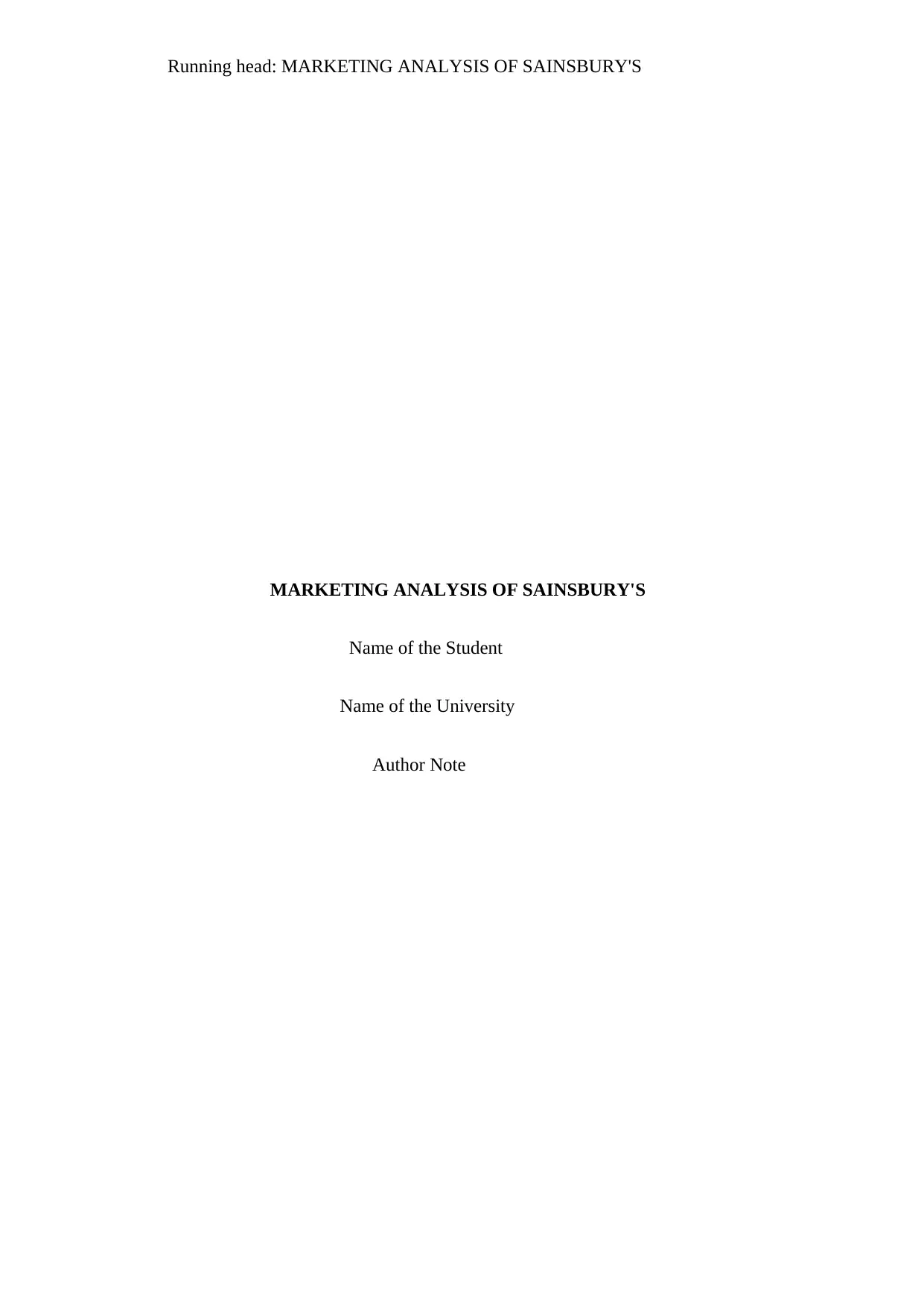
Running head: MARKETING ANALYSIS OF SAINSBURY'S
MARKETING ANALYSIS OF SAINSBURY'S
Name of the Student
Name of the University
Author Note
MARKETING ANALYSIS OF SAINSBURY'S
Name of the Student
Name of the University
Author Note
Paraphrase This Document
Need a fresh take? Get an instant paraphrase of this document with our AI Paraphraser
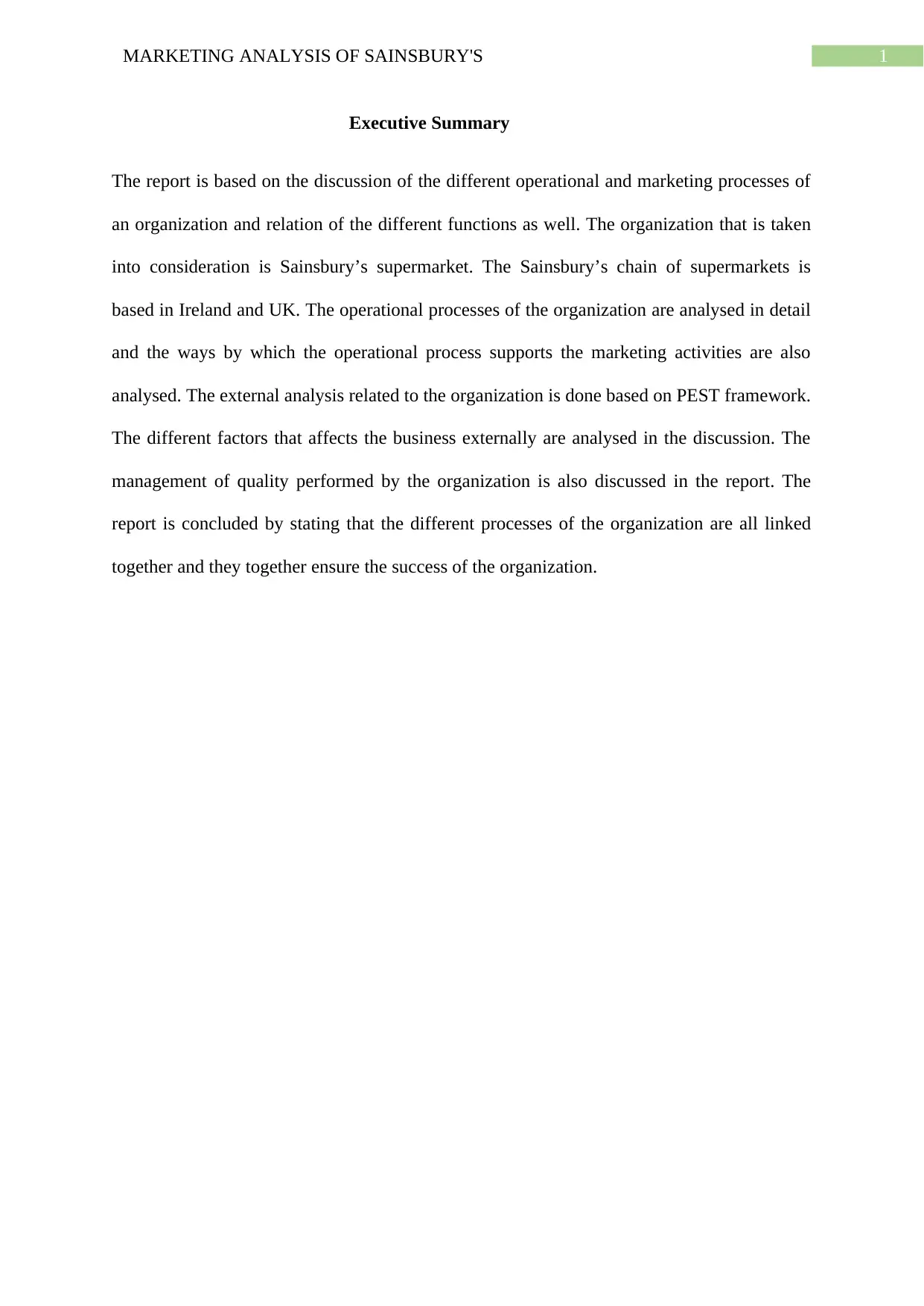
1MARKETING ANALYSIS OF SAINSBURY'S
Executive Summary
The report is based on the discussion of the different operational and marketing processes of
an organization and relation of the different functions as well. The organization that is taken
into consideration is Sainsbury’s supermarket. The Sainsbury’s chain of supermarkets is
based in Ireland and UK. The operational processes of the organization are analysed in detail
and the ways by which the operational process supports the marketing activities are also
analysed. The external analysis related to the organization is done based on PEST framework.
The different factors that affects the business externally are analysed in the discussion. The
management of quality performed by the organization is also discussed in the report. The
report is concluded by stating that the different processes of the organization are all linked
together and they together ensure the success of the organization.
Executive Summary
The report is based on the discussion of the different operational and marketing processes of
an organization and relation of the different functions as well. The organization that is taken
into consideration is Sainsbury’s supermarket. The Sainsbury’s chain of supermarkets is
based in Ireland and UK. The operational processes of the organization are analysed in detail
and the ways by which the operational process supports the marketing activities are also
analysed. The external analysis related to the organization is done based on PEST framework.
The different factors that affects the business externally are analysed in the discussion. The
management of quality performed by the organization is also discussed in the report. The
report is concluded by stating that the different processes of the organization are all linked
together and they together ensure the success of the organization.
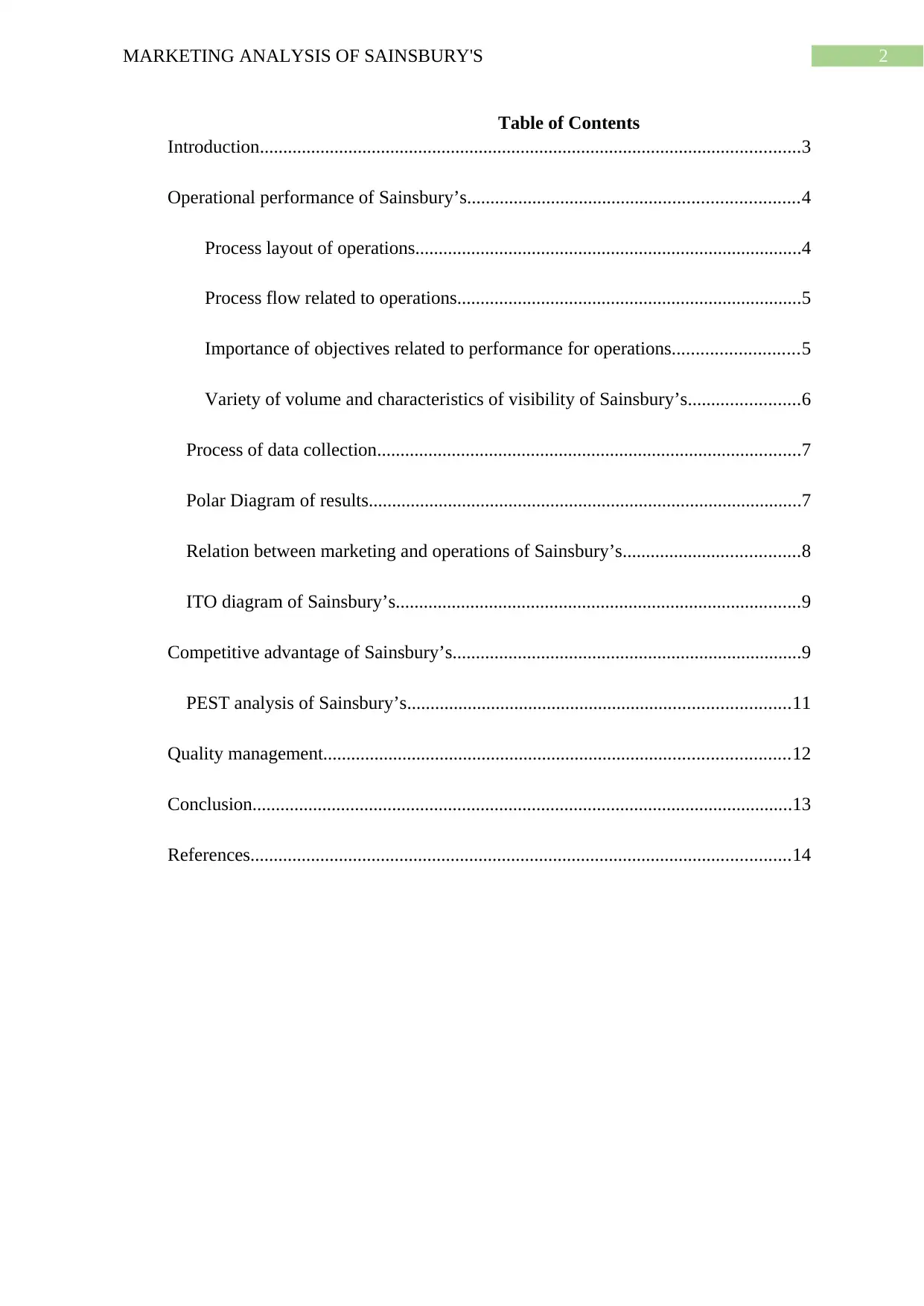
2MARKETING ANALYSIS OF SAINSBURY'S
Table of Contents
Introduction....................................................................................................................3
Operational performance of Sainsbury’s.......................................................................4
Process layout of operations...................................................................................4
Process flow related to operations..........................................................................5
Importance of objectives related to performance for operations...........................5
Variety of volume and characteristics of visibility of Sainsbury’s........................6
Process of data collection...........................................................................................7
Polar Diagram of results.............................................................................................7
Relation between marketing and operations of Sainsbury’s......................................8
ITO diagram of Sainsbury’s.......................................................................................9
Competitive advantage of Sainsbury’s...........................................................................9
PEST analysis of Sainsbury’s..................................................................................11
Quality management....................................................................................................12
Conclusion....................................................................................................................13
References....................................................................................................................14
Table of Contents
Introduction....................................................................................................................3
Operational performance of Sainsbury’s.......................................................................4
Process layout of operations...................................................................................4
Process flow related to operations..........................................................................5
Importance of objectives related to performance for operations...........................5
Variety of volume and characteristics of visibility of Sainsbury’s........................6
Process of data collection...........................................................................................7
Polar Diagram of results.............................................................................................7
Relation between marketing and operations of Sainsbury’s......................................8
ITO diagram of Sainsbury’s.......................................................................................9
Competitive advantage of Sainsbury’s...........................................................................9
PEST analysis of Sainsbury’s..................................................................................11
Quality management....................................................................................................12
Conclusion....................................................................................................................13
References....................................................................................................................14
⊘ This is a preview!⊘
Do you want full access?
Subscribe today to unlock all pages.

Trusted by 1+ million students worldwide
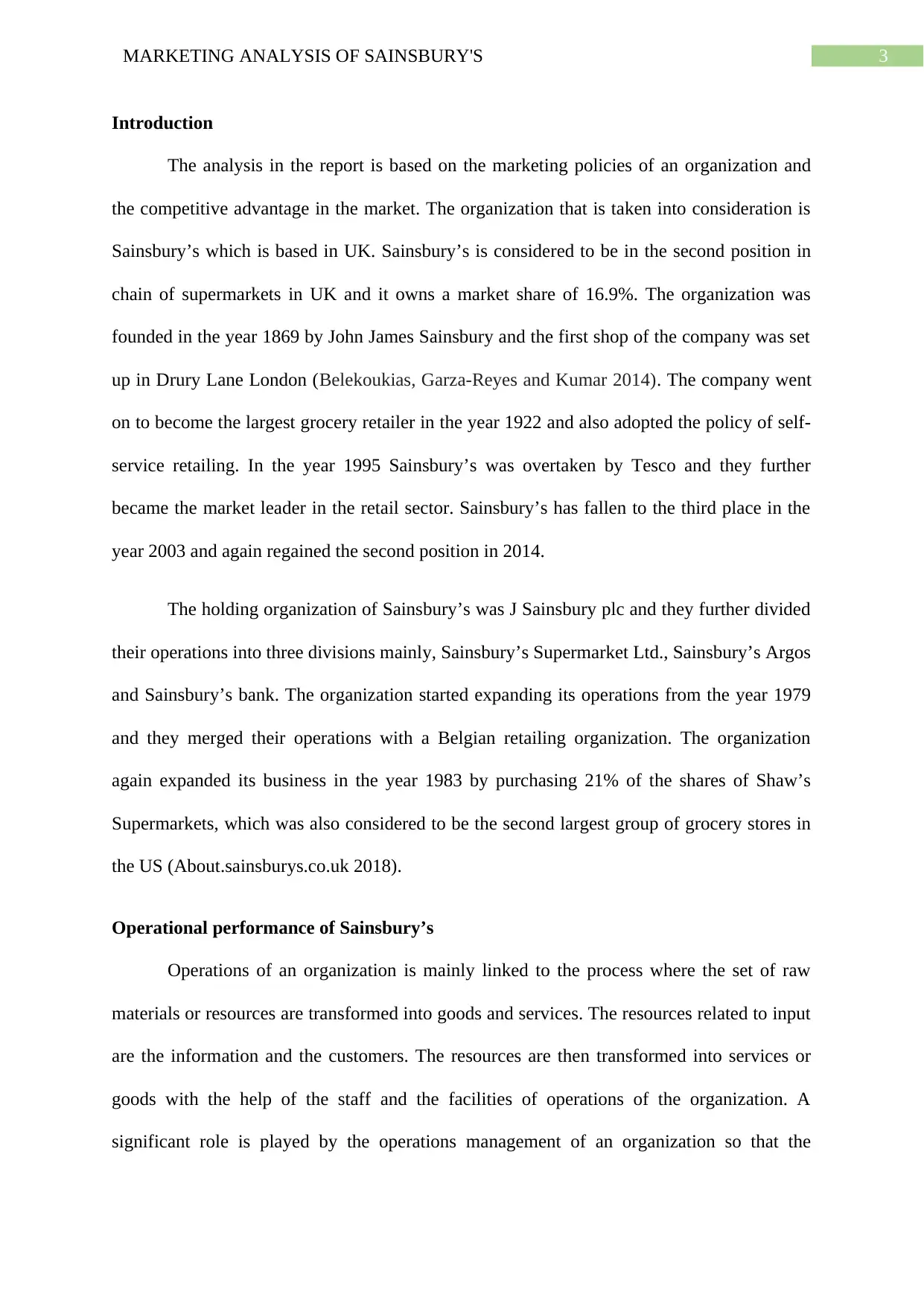
3MARKETING ANALYSIS OF SAINSBURY'S
Introduction
The analysis in the report is based on the marketing policies of an organization and
the competitive advantage in the market. The organization that is taken into consideration is
Sainsbury’s which is based in UK. Sainsbury’s is considered to be in the second position in
chain of supermarkets in UK and it owns a market share of 16.9%. The organization was
founded in the year 1869 by John James Sainsbury and the first shop of the company was set
up in Drury Lane London (Belekoukias, Garza-Reyes and Kumar 2014). The company went
on to become the largest grocery retailer in the year 1922 and also adopted the policy of self-
service retailing. In the year 1995 Sainsbury’s was overtaken by Tesco and they further
became the market leader in the retail sector. Sainsbury’s has fallen to the third place in the
year 2003 and again regained the second position in 2014.
The holding organization of Sainsbury’s was J Sainsbury plc and they further divided
their operations into three divisions mainly, Sainsbury’s Supermarket Ltd., Sainsbury’s Argos
and Sainsbury’s bank. The organization started expanding its operations from the year 1979
and they merged their operations with a Belgian retailing organization. The organization
again expanded its business in the year 1983 by purchasing 21% of the shares of Shaw’s
Supermarkets, which was also considered to be the second largest group of grocery stores in
the US (About.sainsburys.co.uk 2018).
Operational performance of Sainsbury’s
Operations of an organization is mainly linked to the process where the set of raw
materials or resources are transformed into goods and services. The resources related to input
are the information and the customers. The resources are then transformed into services or
goods with the help of the staff and the facilities of operations of the organization. A
significant role is played by the operations management of an organization so that the
Introduction
The analysis in the report is based on the marketing policies of an organization and
the competitive advantage in the market. The organization that is taken into consideration is
Sainsbury’s which is based in UK. Sainsbury’s is considered to be in the second position in
chain of supermarkets in UK and it owns a market share of 16.9%. The organization was
founded in the year 1869 by John James Sainsbury and the first shop of the company was set
up in Drury Lane London (Belekoukias, Garza-Reyes and Kumar 2014). The company went
on to become the largest grocery retailer in the year 1922 and also adopted the policy of self-
service retailing. In the year 1995 Sainsbury’s was overtaken by Tesco and they further
became the market leader in the retail sector. Sainsbury’s has fallen to the third place in the
year 2003 and again regained the second position in 2014.
The holding organization of Sainsbury’s was J Sainsbury plc and they further divided
their operations into three divisions mainly, Sainsbury’s Supermarket Ltd., Sainsbury’s Argos
and Sainsbury’s bank. The organization started expanding its operations from the year 1979
and they merged their operations with a Belgian retailing organization. The organization
again expanded its business in the year 1983 by purchasing 21% of the shares of Shaw’s
Supermarkets, which was also considered to be the second largest group of grocery stores in
the US (About.sainsburys.co.uk 2018).
Operational performance of Sainsbury’s
Operations of an organization is mainly linked to the process where the set of raw
materials or resources are transformed into goods and services. The resources related to input
are the information and the customers. The resources are then transformed into services or
goods with the help of the staff and the facilities of operations of the organization. A
significant role is played by the operations management of an organization so that the
Paraphrase This Document
Need a fresh take? Get an instant paraphrase of this document with our AI Paraphraser
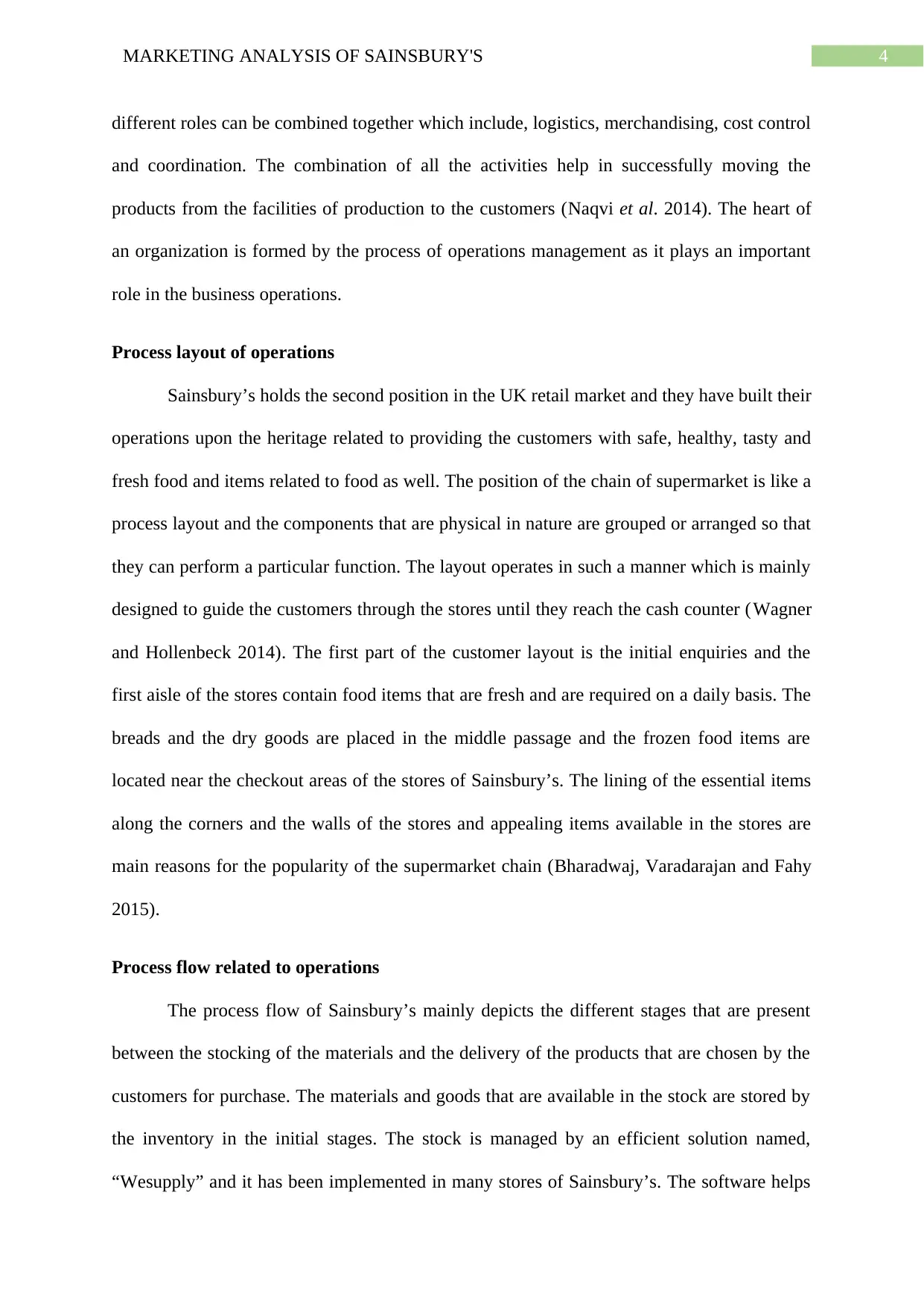
4MARKETING ANALYSIS OF SAINSBURY'S
different roles can be combined together which include, logistics, merchandising, cost control
and coordination. The combination of all the activities help in successfully moving the
products from the facilities of production to the customers (Naqvi et al. 2014). The heart of
an organization is formed by the process of operations management as it plays an important
role in the business operations.
Process layout of operations
Sainsbury’s holds the second position in the UK retail market and they have built their
operations upon the heritage related to providing the customers with safe, healthy, tasty and
fresh food and items related to food as well. The position of the chain of supermarket is like a
process layout and the components that are physical in nature are grouped or arranged so that
they can perform a particular function. The layout operates in such a manner which is mainly
designed to guide the customers through the stores until they reach the cash counter (Wagner
and Hollenbeck 2014). The first part of the customer layout is the initial enquiries and the
first aisle of the stores contain food items that are fresh and are required on a daily basis. The
breads and the dry goods are placed in the middle passage and the frozen food items are
located near the checkout areas of the stores of Sainsbury’s. The lining of the essential items
along the corners and the walls of the stores and appealing items available in the stores are
main reasons for the popularity of the supermarket chain (Bharadwaj, Varadarajan and Fahy
2015).
Process flow related to operations
The process flow of Sainsbury’s mainly depicts the different stages that are present
between the stocking of the materials and the delivery of the products that are chosen by the
customers for purchase. The materials and goods that are available in the stock are stored by
the inventory in the initial stages. The stock is managed by an efficient solution named,
“Wesupply” and it has been implemented in many stores of Sainsbury’s. The software helps
different roles can be combined together which include, logistics, merchandising, cost control
and coordination. The combination of all the activities help in successfully moving the
products from the facilities of production to the customers (Naqvi et al. 2014). The heart of
an organization is formed by the process of operations management as it plays an important
role in the business operations.
Process layout of operations
Sainsbury’s holds the second position in the UK retail market and they have built their
operations upon the heritage related to providing the customers with safe, healthy, tasty and
fresh food and items related to food as well. The position of the chain of supermarket is like a
process layout and the components that are physical in nature are grouped or arranged so that
they can perform a particular function. The layout operates in such a manner which is mainly
designed to guide the customers through the stores until they reach the cash counter (Wagner
and Hollenbeck 2014). The first part of the customer layout is the initial enquiries and the
first aisle of the stores contain food items that are fresh and are required on a daily basis. The
breads and the dry goods are placed in the middle passage and the frozen food items are
located near the checkout areas of the stores of Sainsbury’s. The lining of the essential items
along the corners and the walls of the stores and appealing items available in the stores are
main reasons for the popularity of the supermarket chain (Bharadwaj, Varadarajan and Fahy
2015).
Process flow related to operations
The process flow of Sainsbury’s mainly depicts the different stages that are present
between the stocking of the materials and the delivery of the products that are chosen by the
customers for purchase. The materials and goods that are available in the stock are stored by
the inventory in the initial stages. The stock is managed by an efficient solution named,
“Wesupply” and it has been implemented in many stores of Sainsbury’s. The software helps
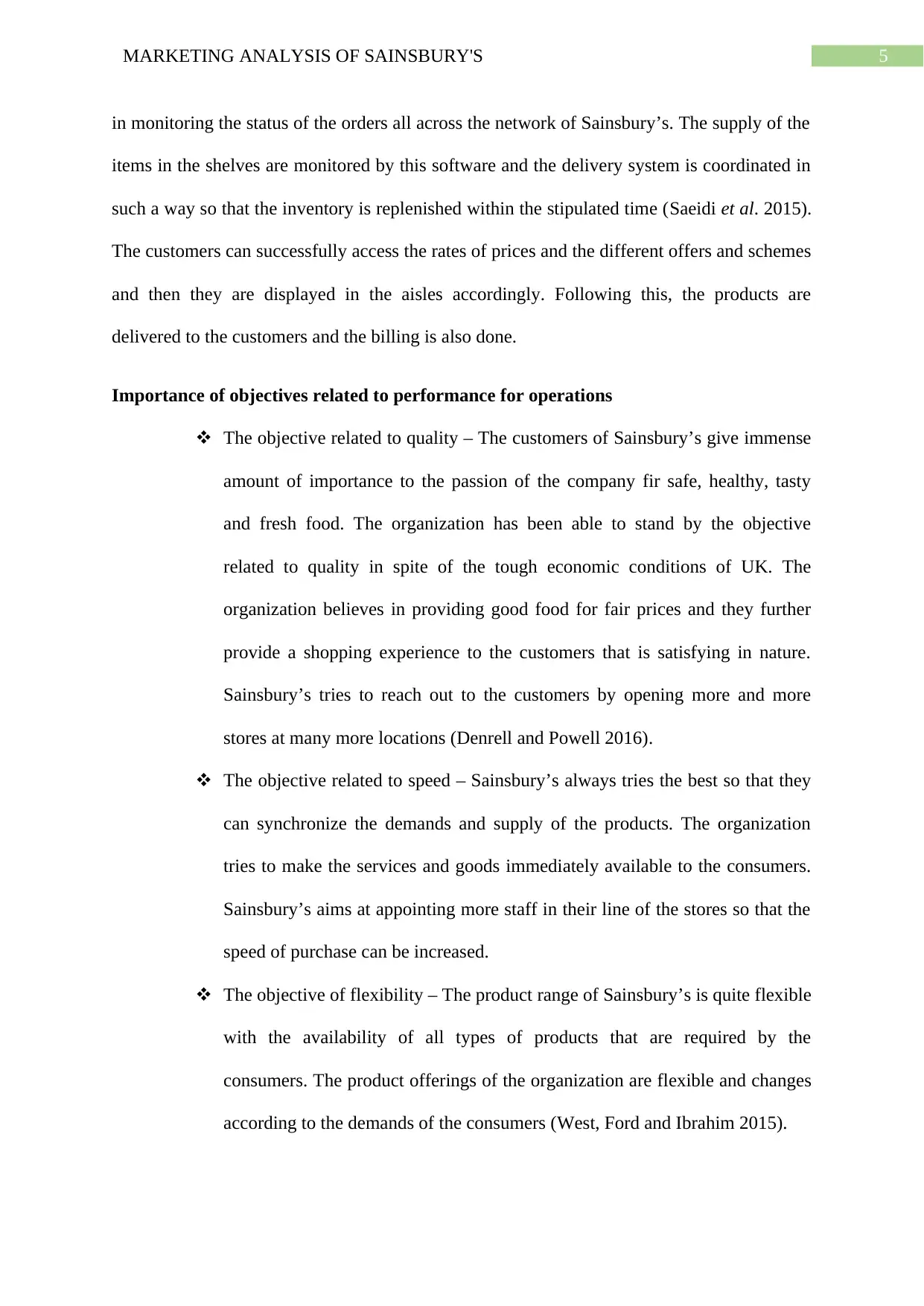
5MARKETING ANALYSIS OF SAINSBURY'S
in monitoring the status of the orders all across the network of Sainsbury’s. The supply of the
items in the shelves are monitored by this software and the delivery system is coordinated in
such a way so that the inventory is replenished within the stipulated time (Saeidi et al. 2015).
The customers can successfully access the rates of prices and the different offers and schemes
and then they are displayed in the aisles accordingly. Following this, the products are
delivered to the customers and the billing is also done.
Importance of objectives related to performance for operations
The objective related to quality – The customers of Sainsbury’s give immense
amount of importance to the passion of the company fir safe, healthy, tasty
and fresh food. The organization has been able to stand by the objective
related to quality in spite of the tough economic conditions of UK. The
organization believes in providing good food for fair prices and they further
provide a shopping experience to the customers that is satisfying in nature.
Sainsbury’s tries to reach out to the customers by opening more and more
stores at many more locations (Denrell and Powell 2016).
The objective related to speed – Sainsbury’s always tries the best so that they
can synchronize the demands and supply of the products. The organization
tries to make the services and goods immediately available to the consumers.
Sainsbury’s aims at appointing more staff in their line of the stores so that the
speed of purchase can be increased.
The objective of flexibility – The product range of Sainsbury’s is quite flexible
with the availability of all types of products that are required by the
consumers. The product offerings of the organization are flexible and changes
according to the demands of the consumers (West, Ford and Ibrahim 2015).
in monitoring the status of the orders all across the network of Sainsbury’s. The supply of the
items in the shelves are monitored by this software and the delivery system is coordinated in
such a way so that the inventory is replenished within the stipulated time (Saeidi et al. 2015).
The customers can successfully access the rates of prices and the different offers and schemes
and then they are displayed in the aisles accordingly. Following this, the products are
delivered to the customers and the billing is also done.
Importance of objectives related to performance for operations
The objective related to quality – The customers of Sainsbury’s give immense
amount of importance to the passion of the company fir safe, healthy, tasty
and fresh food. The organization has been able to stand by the objective
related to quality in spite of the tough economic conditions of UK. The
organization believes in providing good food for fair prices and they further
provide a shopping experience to the customers that is satisfying in nature.
Sainsbury’s tries to reach out to the customers by opening more and more
stores at many more locations (Denrell and Powell 2016).
The objective related to speed – Sainsbury’s always tries the best so that they
can synchronize the demands and supply of the products. The organization
tries to make the services and goods immediately available to the consumers.
Sainsbury’s aims at appointing more staff in their line of the stores so that the
speed of purchase can be increased.
The objective of flexibility – The product range of Sainsbury’s is quite flexible
with the availability of all types of products that are required by the
consumers. The product offerings of the organization are flexible and changes
according to the demands of the consumers (West, Ford and Ibrahim 2015).
⊘ This is a preview!⊘
Do you want full access?
Subscribe today to unlock all pages.

Trusted by 1+ million students worldwide
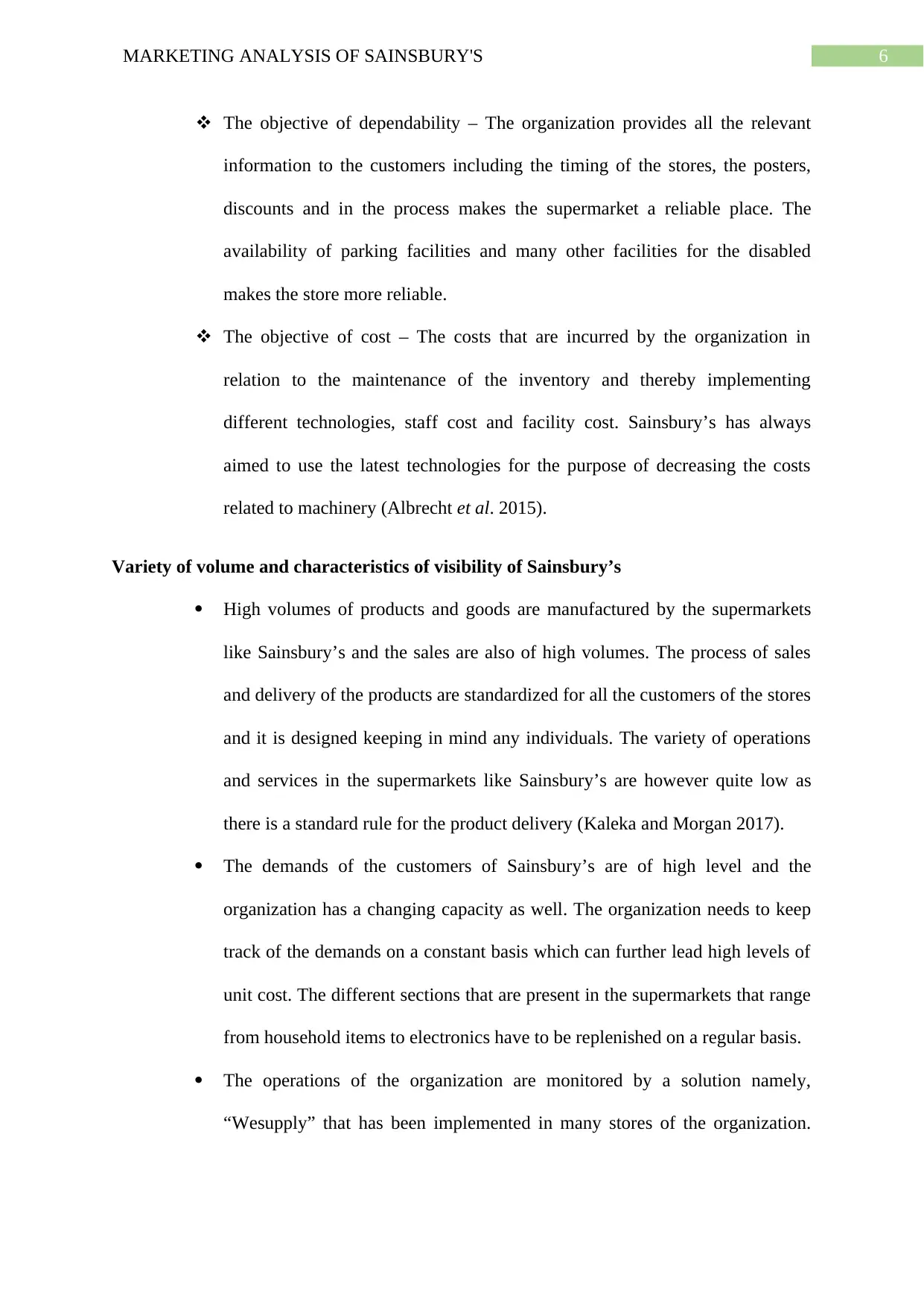
6MARKETING ANALYSIS OF SAINSBURY'S
The objective of dependability – The organization provides all the relevant
information to the customers including the timing of the stores, the posters,
discounts and in the process makes the supermarket a reliable place. The
availability of parking facilities and many other facilities for the disabled
makes the store more reliable.
The objective of cost – The costs that are incurred by the organization in
relation to the maintenance of the inventory and thereby implementing
different technologies, staff cost and facility cost. Sainsbury’s has always
aimed to use the latest technologies for the purpose of decreasing the costs
related to machinery (Albrecht et al. 2015).
Variety of volume and characteristics of visibility of Sainsbury’s
High volumes of products and goods are manufactured by the supermarkets
like Sainsbury’s and the sales are also of high volumes. The process of sales
and delivery of the products are standardized for all the customers of the stores
and it is designed keeping in mind any individuals. The variety of operations
and services in the supermarkets like Sainsbury’s are however quite low as
there is a standard rule for the product delivery (Kaleka and Morgan 2017).
The demands of the customers of Sainsbury’s are of high level and the
organization has a changing capacity as well. The organization needs to keep
track of the demands on a constant basis which can further lead high levels of
unit cost. The different sections that are present in the supermarkets that range
from household items to electronics have to be replenished on a regular basis.
The operations of the organization are monitored by a solution namely,
“Wesupply” that has been implemented in many stores of the organization.
The objective of dependability – The organization provides all the relevant
information to the customers including the timing of the stores, the posters,
discounts and in the process makes the supermarket a reliable place. The
availability of parking facilities and many other facilities for the disabled
makes the store more reliable.
The objective of cost – The costs that are incurred by the organization in
relation to the maintenance of the inventory and thereby implementing
different technologies, staff cost and facility cost. Sainsbury’s has always
aimed to use the latest technologies for the purpose of decreasing the costs
related to machinery (Albrecht et al. 2015).
Variety of volume and characteristics of visibility of Sainsbury’s
High volumes of products and goods are manufactured by the supermarkets
like Sainsbury’s and the sales are also of high volumes. The process of sales
and delivery of the products are standardized for all the customers of the stores
and it is designed keeping in mind any individuals. The variety of operations
and services in the supermarkets like Sainsbury’s are however quite low as
there is a standard rule for the product delivery (Kaleka and Morgan 2017).
The demands of the customers of Sainsbury’s are of high level and the
organization has a changing capacity as well. The organization needs to keep
track of the demands on a constant basis which can further lead high levels of
unit cost. The different sections that are present in the supermarkets that range
from household items to electronics have to be replenished on a regular basis.
The operations of the organization are monitored by a solution namely,
“Wesupply” that has been implemented in many stores of the organization.
Paraphrase This Document
Need a fresh take? Get an instant paraphrase of this document with our AI Paraphraser
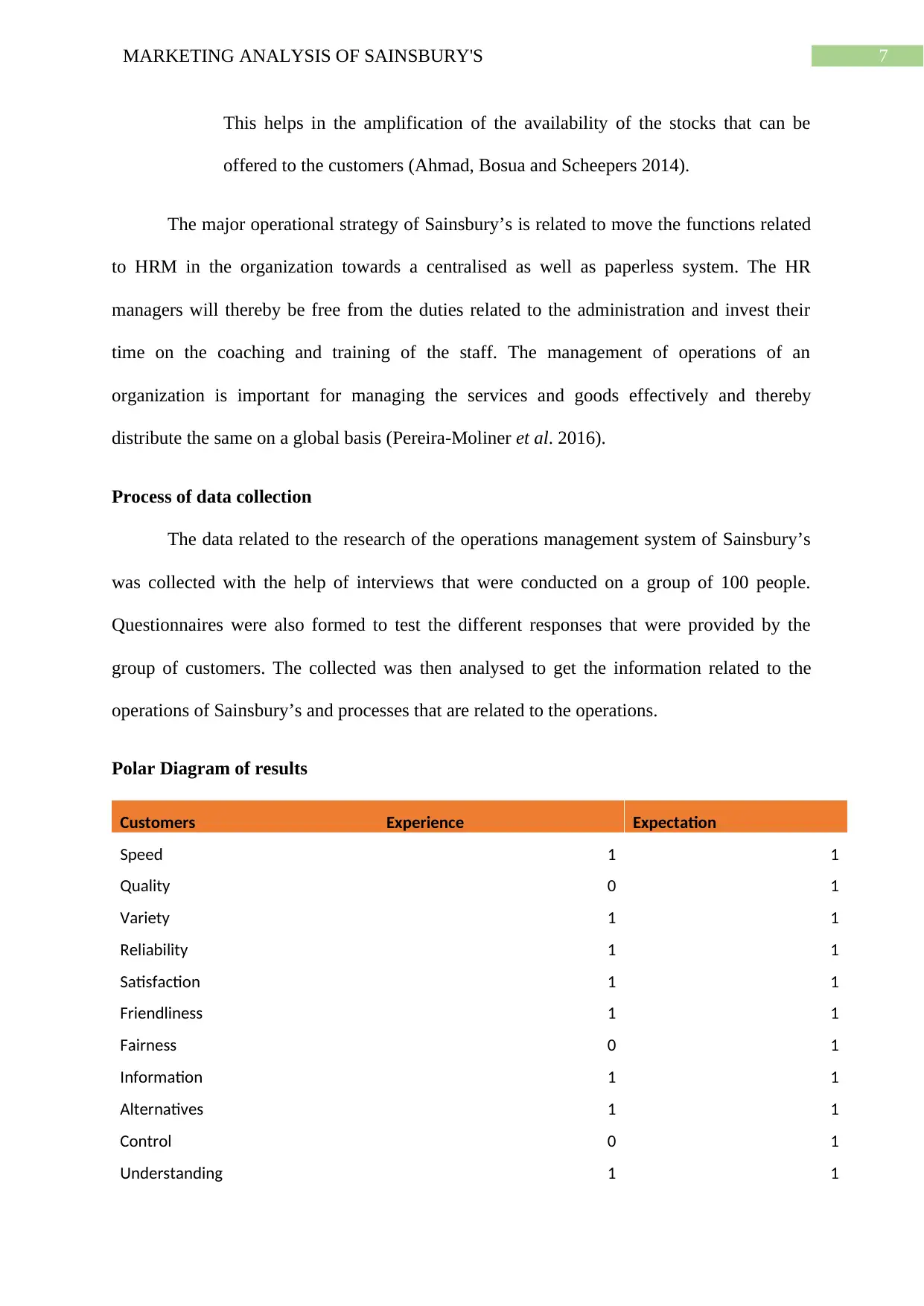
7MARKETING ANALYSIS OF SAINSBURY'S
This helps in the amplification of the availability of the stocks that can be
offered to the customers (Ahmad, Bosua and Scheepers 2014).
The major operational strategy of Sainsbury’s is related to move the functions related
to HRM in the organization towards a centralised as well as paperless system. The HR
managers will thereby be free from the duties related to the administration and invest their
time on the coaching and training of the staff. The management of operations of an
organization is important for managing the services and goods effectively and thereby
distribute the same on a global basis (Pereira-Moliner et al. 2016).
Process of data collection
The data related to the research of the operations management system of Sainsbury’s
was collected with the help of interviews that were conducted on a group of 100 people.
Questionnaires were also formed to test the different responses that were provided by the
group of customers. The collected was then analysed to get the information related to the
operations of Sainsbury’s and processes that are related to the operations.
Polar Diagram of results
Customers Experience Expectation
Speed 1 1
Quality 0 1
Variety 1 1
Reliability 1 1
Satisfaction 1 1
Friendliness 1 1
Fairness 0 1
Information 1 1
Alternatives 1 1
Control 0 1
Understanding 1 1
This helps in the amplification of the availability of the stocks that can be
offered to the customers (Ahmad, Bosua and Scheepers 2014).
The major operational strategy of Sainsbury’s is related to move the functions related
to HRM in the organization towards a centralised as well as paperless system. The HR
managers will thereby be free from the duties related to the administration and invest their
time on the coaching and training of the staff. The management of operations of an
organization is important for managing the services and goods effectively and thereby
distribute the same on a global basis (Pereira-Moliner et al. 2016).
Process of data collection
The data related to the research of the operations management system of Sainsbury’s
was collected with the help of interviews that were conducted on a group of 100 people.
Questionnaires were also formed to test the different responses that were provided by the
group of customers. The collected was then analysed to get the information related to the
operations of Sainsbury’s and processes that are related to the operations.
Polar Diagram of results
Customers Experience Expectation
Speed 1 1
Quality 0 1
Variety 1 1
Reliability 1 1
Satisfaction 1 1
Friendliness 1 1
Fairness 0 1
Information 1 1
Alternatives 1 1
Control 0 1
Understanding 1 1
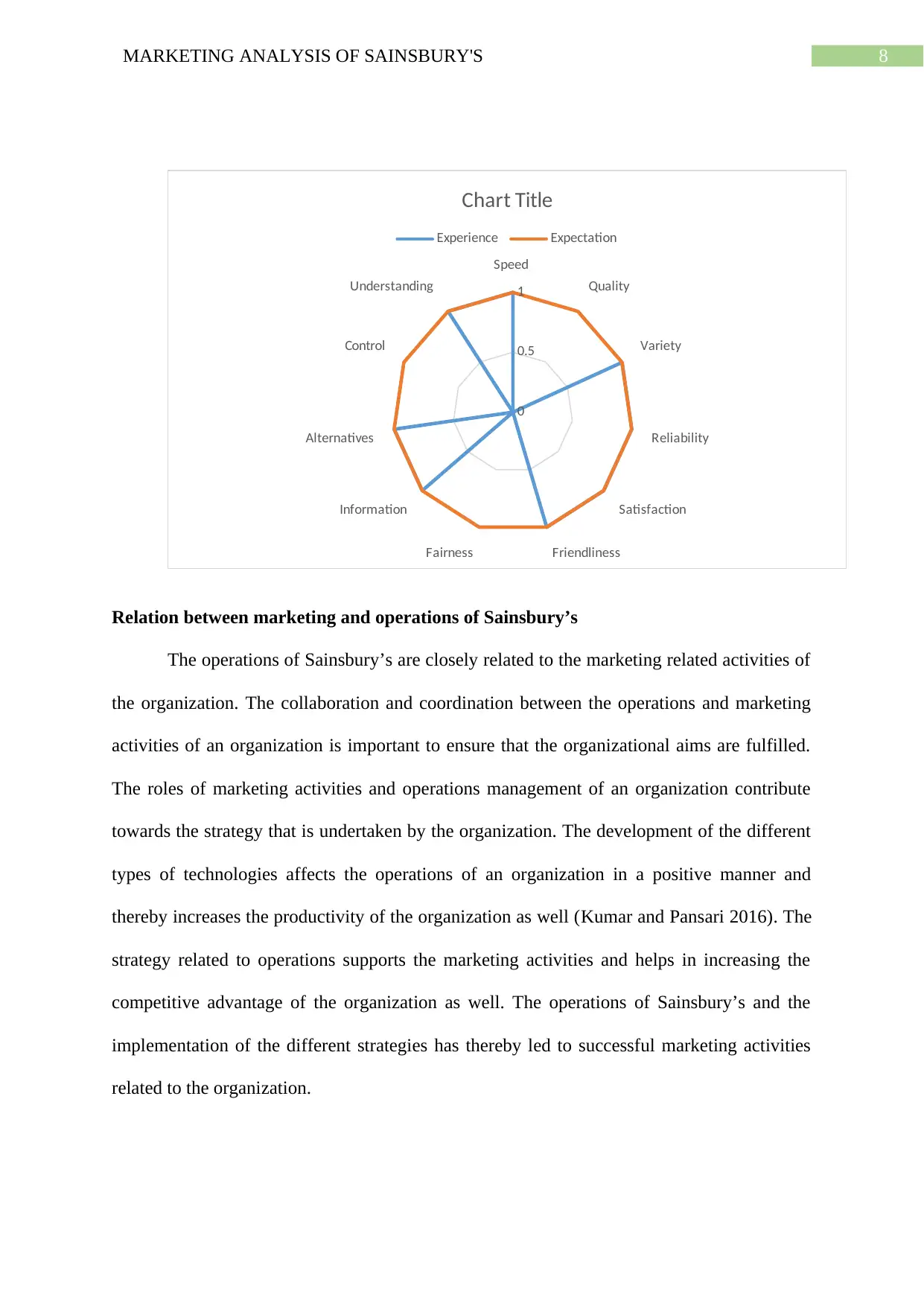
8MARKETING ANALYSIS OF SAINSBURY'S
Speed
Quality
Variety
Reliability
Satisfaction
FriendlinessFairness
Information
Alternatives
Control
Understanding
0
0.5
1
Chart Title
Experience Expectation
Relation between marketing and operations of Sainsbury’s
The operations of Sainsbury’s are closely related to the marketing related activities of
the organization. The collaboration and coordination between the operations and marketing
activities of an organization is important to ensure that the organizational aims are fulfilled.
The roles of marketing activities and operations management of an organization contribute
towards the strategy that is undertaken by the organization. The development of the different
types of technologies affects the operations of an organization in a positive manner and
thereby increases the productivity of the organization as well (Kumar and Pansari 2016). The
strategy related to operations supports the marketing activities and helps in increasing the
competitive advantage of the organization as well. The operations of Sainsbury’s and the
implementation of the different strategies has thereby led to successful marketing activities
related to the organization.
Speed
Quality
Variety
Reliability
Satisfaction
FriendlinessFairness
Information
Alternatives
Control
Understanding
0
0.5
1
Chart Title
Experience Expectation
Relation between marketing and operations of Sainsbury’s
The operations of Sainsbury’s are closely related to the marketing related activities of
the organization. The collaboration and coordination between the operations and marketing
activities of an organization is important to ensure that the organizational aims are fulfilled.
The roles of marketing activities and operations management of an organization contribute
towards the strategy that is undertaken by the organization. The development of the different
types of technologies affects the operations of an organization in a positive manner and
thereby increases the productivity of the organization as well (Kumar and Pansari 2016). The
strategy related to operations supports the marketing activities and helps in increasing the
competitive advantage of the organization as well. The operations of Sainsbury’s and the
implementation of the different strategies has thereby led to successful marketing activities
related to the organization.
⊘ This is a preview!⊘
Do you want full access?
Subscribe today to unlock all pages.

Trusted by 1+ million students worldwide
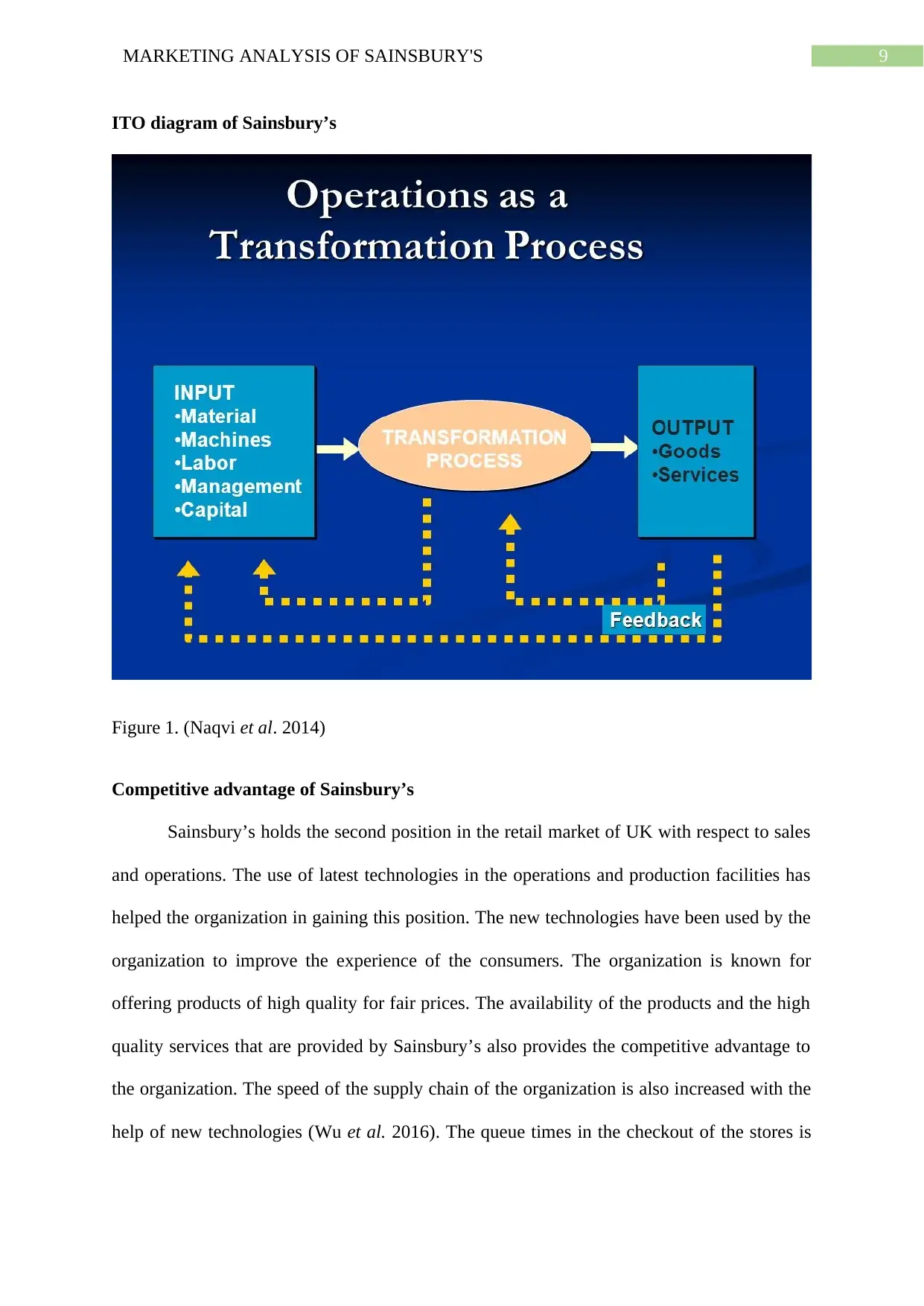
9MARKETING ANALYSIS OF SAINSBURY'S
ITO diagram of Sainsbury’s
Figure 1. (Naqvi et al. 2014)
Competitive advantage of Sainsbury’s
Sainsbury’s holds the second position in the retail market of UK with respect to sales
and operations. The use of latest technologies in the operations and production facilities has
helped the organization in gaining this position. The new technologies have been used by the
organization to improve the experience of the consumers. The organization is known for
offering products of high quality for fair prices. The availability of the products and the high
quality services that are provided by Sainsbury’s also provides the competitive advantage to
the organization. The speed of the supply chain of the organization is also increased with the
help of new technologies (Wu et al. 2016). The queue times in the checkout of the stores is
ITO diagram of Sainsbury’s
Figure 1. (Naqvi et al. 2014)
Competitive advantage of Sainsbury’s
Sainsbury’s holds the second position in the retail market of UK with respect to sales
and operations. The use of latest technologies in the operations and production facilities has
helped the organization in gaining this position. The new technologies have been used by the
organization to improve the experience of the consumers. The organization is known for
offering products of high quality for fair prices. The availability of the products and the high
quality services that are provided by Sainsbury’s also provides the competitive advantage to
the organization. The speed of the supply chain of the organization is also increased with the
help of new technologies (Wu et al. 2016). The queue times in the checkout of the stores is
Paraphrase This Document
Need a fresh take? Get an instant paraphrase of this document with our AI Paraphraser
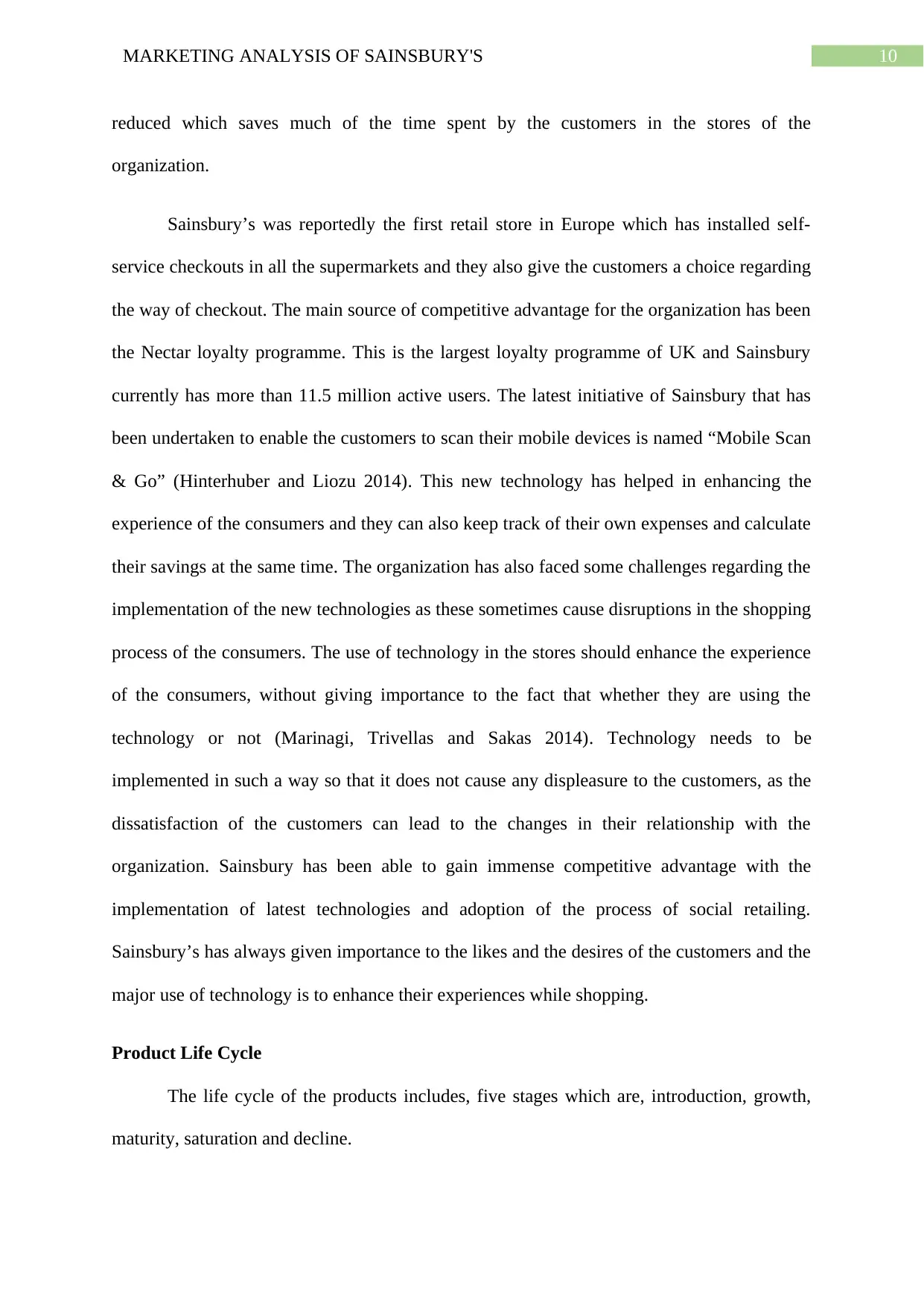
10MARKETING ANALYSIS OF SAINSBURY'S
reduced which saves much of the time spent by the customers in the stores of the
organization.
Sainsbury’s was reportedly the first retail store in Europe which has installed self-
service checkouts in all the supermarkets and they also give the customers a choice regarding
the way of checkout. The main source of competitive advantage for the organization has been
the Nectar loyalty programme. This is the largest loyalty programme of UK and Sainsbury
currently has more than 11.5 million active users. The latest initiative of Sainsbury that has
been undertaken to enable the customers to scan their mobile devices is named “Mobile Scan
& Go” (Hinterhuber and Liozu 2014). This new technology has helped in enhancing the
experience of the consumers and they can also keep track of their own expenses and calculate
their savings at the same time. The organization has also faced some challenges regarding the
implementation of the new technologies as these sometimes cause disruptions in the shopping
process of the consumers. The use of technology in the stores should enhance the experience
of the consumers, without giving importance to the fact that whether they are using the
technology or not (Marinagi, Trivellas and Sakas 2014). Technology needs to be
implemented in such a way so that it does not cause any displeasure to the customers, as the
dissatisfaction of the customers can lead to the changes in their relationship with the
organization. Sainsbury has been able to gain immense competitive advantage with the
implementation of latest technologies and adoption of the process of social retailing.
Sainsbury’s has always given importance to the likes and the desires of the customers and the
major use of technology is to enhance their experiences while shopping.
Product Life Cycle
The life cycle of the products includes, five stages which are, introduction, growth,
maturity, saturation and decline.
reduced which saves much of the time spent by the customers in the stores of the
organization.
Sainsbury’s was reportedly the first retail store in Europe which has installed self-
service checkouts in all the supermarkets and they also give the customers a choice regarding
the way of checkout. The main source of competitive advantage for the organization has been
the Nectar loyalty programme. This is the largest loyalty programme of UK and Sainsbury
currently has more than 11.5 million active users. The latest initiative of Sainsbury that has
been undertaken to enable the customers to scan their mobile devices is named “Mobile Scan
& Go” (Hinterhuber and Liozu 2014). This new technology has helped in enhancing the
experience of the consumers and they can also keep track of their own expenses and calculate
their savings at the same time. The organization has also faced some challenges regarding the
implementation of the new technologies as these sometimes cause disruptions in the shopping
process of the consumers. The use of technology in the stores should enhance the experience
of the consumers, without giving importance to the fact that whether they are using the
technology or not (Marinagi, Trivellas and Sakas 2014). Technology needs to be
implemented in such a way so that it does not cause any displeasure to the customers, as the
dissatisfaction of the customers can lead to the changes in their relationship with the
organization. Sainsbury has been able to gain immense competitive advantage with the
implementation of latest technologies and adoption of the process of social retailing.
Sainsbury’s has always given importance to the likes and the desires of the customers and the
major use of technology is to enhance their experiences while shopping.
Product Life Cycle
The life cycle of the products includes, five stages which are, introduction, growth,
maturity, saturation and decline.
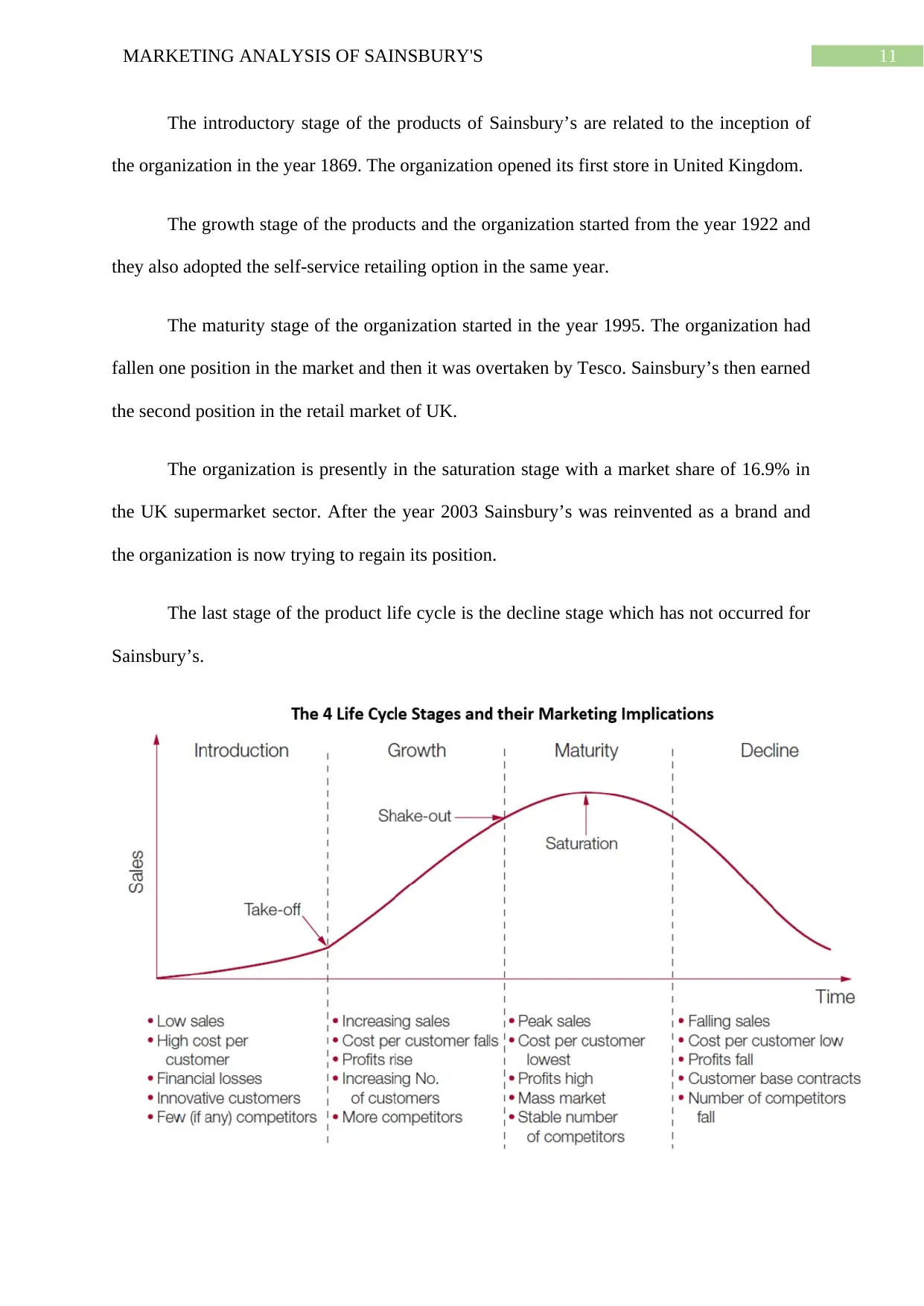
11MARKETING ANALYSIS OF SAINSBURY'S
The introductory stage of the products of Sainsbury’s are related to the inception of
the organization in the year 1869. The organization opened its first store in United Kingdom.
The growth stage of the products and the organization started from the year 1922 and
they also adopted the self-service retailing option in the same year.
The maturity stage of the organization started in the year 1995. The organization had
fallen one position in the market and then it was overtaken by Tesco. Sainsbury’s then earned
the second position in the retail market of UK.
The organization is presently in the saturation stage with a market share of 16.9% in
the UK supermarket sector. After the year 2003 Sainsbury’s was reinvented as a brand and
the organization is now trying to regain its position.
The last stage of the product life cycle is the decline stage which has not occurred for
Sainsbury’s.
The introductory stage of the products of Sainsbury’s are related to the inception of
the organization in the year 1869. The organization opened its first store in United Kingdom.
The growth stage of the products and the organization started from the year 1922 and
they also adopted the self-service retailing option in the same year.
The maturity stage of the organization started in the year 1995. The organization had
fallen one position in the market and then it was overtaken by Tesco. Sainsbury’s then earned
the second position in the retail market of UK.
The organization is presently in the saturation stage with a market share of 16.9% in
the UK supermarket sector. After the year 2003 Sainsbury’s was reinvented as a brand and
the organization is now trying to regain its position.
The last stage of the product life cycle is the decline stage which has not occurred for
Sainsbury’s.
⊘ This is a preview!⊘
Do you want full access?
Subscribe today to unlock all pages.

Trusted by 1+ million students worldwide
1 out of 18
Related Documents
Your All-in-One AI-Powered Toolkit for Academic Success.
+13062052269
info@desklib.com
Available 24*7 on WhatsApp / Email
![[object Object]](/_next/static/media/star-bottom.7253800d.svg)
Unlock your academic potential
Copyright © 2020–2025 A2Z Services. All Rights Reserved. Developed and managed by ZUCOL.





